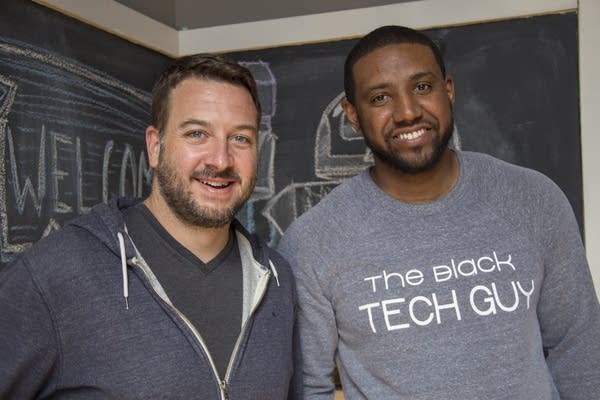Witness my traffic stop: New app seeks crowd safety for people of color

Go Deeper.
Create an account or log in to save stories.
Like this?
Thanks for liking this story! We have added it to a list of your favorite stories.
Mondo Davison was driving on Interstate 94 in St. Paul at 3 a.m. when a police car's lights began flashing behind him. It was June 2016, just seven months after Minneapolis police officers had shot and killed Jamar Clark. The deaths of other African-Americans at the hands of police had filled headlines and fueled protests around the country.
"I was just scared," recalled, Davison, who's black. "I'm on the freeway, and I'm not really feeling like pulling over with nobody else on the freeway with me."
Davison stopped near the Dale Street exit, "just hoping maybe somebody's walking around ... to see what's going on. That didn't happen, but I wish that could've happen."
Davison, 32, was fine that night. But the next month Philando Castile was shot and killed by a St. Anthony police officer during a traffic stop.
Turn Up Your Support
MPR News helps you turn down the noise and build shared understanding. Turn up your support for this public resource and keep trusted journalism accessible to all.
Davison and Castile had attended St. Paul Central High school together.
"When it happened to somebody I literally knew and crossed paths with. [I said to myself,] 'You need to do something right now.'"
Davison, who is the founder of several app-based startups and calls himself "The Black Tech Guy," turned to technology for a solution.
Through a partnership with Software for Good, the mobile app SafeSpace was born.

SafeSpace is designed to do what Davison couldn't in 2016 — summon allies to the scene of a police stop to record it.
An iPhone version of the free app officially launched this week.
Davison said the goal is to head off overuse of police force in communities of color, and save lives.
"I don't want to die and I don't want somebody I know to die at the hands of law enforcement when it was likely unwarranted," he said.
Software for Good, is a Minneapolis-based for-profit, public benefit corporation that develops software for organizations "working toward positive environmental and social change."
"When Mondo brought this idea to basically crowd source safety using a mobile app, we were like 'that's exactly the stuff that we do,'" said Casey Helbling, founder and CEO. "We build mobile apps and web apps to basically make the world a better place."
SafeSpace is a one-button tap that simultaneously notifies the motorist's emergency contacts, like family members and friends, of their police stop and nearby users to respond to the scene.
App users within a half mile of a motorist's request receive alerts to come to the scene as allies. They can accept or decline. At the scene, the app will instruct them to stand at least 15 feet away from the encounter.

Helbling, who is white, said there's an existing community of white allies eager to play a role in addressing the problem.
He said the SafeSpace app will be an effective tool for them to get involved.
The data generated from the app could reveal the scale of police brutality, said Helbling, 41.
"Once we start accumulating all these incidents, we could start looking at the data and compare it to actual published public reports to better understand what the real narrative is," he said. "Is it what the police department and city are telling us, or is it what we're seeing through the use of this tool."
The American Civil Liberties Union has an app with a similar aim, which records interactions with police and automatically sends them to the organization.
Davison and Helbling said they plan to see if there's a market for the SafeSpace app.
But there's one big unanswered question: How will police officers respond?
Davison and Helbling didn't consult with law enforcement experts in developing the app. MPR News reached out to three local police departments and the John Jay College of Criminal Justice. None agreed to comment.
But to avoid drawing a crowd to a scene and making matters worst, the app will limit the number of responders. Voice activation is being considered to prevent spooking a cop with a reach for a phone.
But Davison hopes the mere advent of the SafeSpace app is a revelation to law enforcement.
"Man, these guys literally had to build out a tool to ask people to come witness what was going on because they didn't feel safe," Davison said. "If they went through all that effort, there must be a problem. So, let's talk about it."
After every incident, SafeSpace users complete what's called a "safety check," a questionnaire that asks things like: Did you feel safe or unsafe?
Davison said users can also include responding officers' names, badge numbers, departments and rate them.
"Most people would say not all cops are bad, right?" he said. "And I agree with that, but then if you go further and ask which cops are good and which cops aren't, there is no answer. I think SafeSpace, overtime, is going to be able to filter through the cops that do need more professional development and don't need to be on the force and those that are exceptional. And those are the cops we can rally behind as a community. That's a long-term play."
Davison believes mutual suspicion is at the root of the problem. He said people of color are too fearful of police and police are too fearful of people of color. But he said the SafeSpace is a tool that could spark communication and help repair community-police ties.
"Once you build those relationships, I feel like less people are going to die," Davison said.
Davison and Helbling are now fundraising to add features, develop an Android version of the app and launch in other cities.


